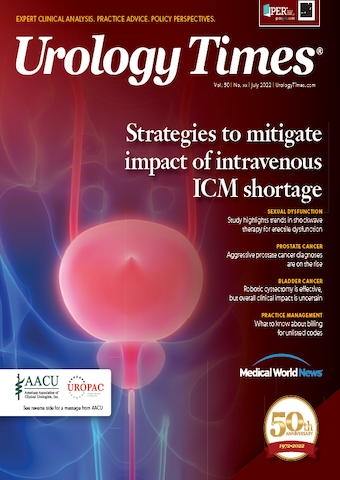Publication
Article
Urology Times Journal
Urology Coding: Can CPT 51728 and 51741 be billed together?
Author(s):
"There are a number of urodynamic tests that can be performed. Urodynamic studies are not a one-size-fits-all procedure, but rather the tests performed should be chosen based upon the patient presentation and the question that needs to be answered by the urodynamic studies," write Jonathan Rubenstein, MD, and Mark Painter.
My provider performed urodynamics for a man with benign prostatic hyperplasia (BPH) and performed a complex cystogram using calibrated electronic equipment with a pressure flow test. My provider pulled CPT codes 51728 and 51741. I didn’t see a separate uroflow test documented to bill CPT code 51741, but my provider advised me that the uroflow was recorded during the pressure flow part of the examination, so their coding was correct. Who is correct?
Jonathan Rubenstein, MD

There are a number of urodynamic tests that can be performed. Urodynamic studies are not a one-size-fits-all procedure, but rather the tests performed should be chosen based upon the patient presentation and the question that needs to be answered by the urodynamic studies. Only the medically necessary tests should be billed, and only the tests that need to be performed should be performed. In this particular case, the patient had BPH-type symptoms and therefore the question that needs to be answered is whether the patient’s voiding symptoms were due to obstruction or not. This is best answered using a pressure-flow test. Therefore, the best test to perform is CPT code 51728 (Complex cystometrogram; with voiding pressure studies[ie, bladder voiding pressure)], any technique). (In addition, the add-on CPT code +51797 [Voiding pressure studies, intra-abdominal] [ie, rectal, gastric, intraperitoneal], which is an add-on code to bill with 51728 or 51729, can be billed if performed.)
Mark Painter

The other diagnostic test that is often used for men with BPH symptoms is CPT 51741 (Complex uroflowmetry [eg, calibrated electronic equipment]). Uroflowmetry measures the urine flow electronically, with the flow rate reflecting the combined activity of the detrusor muscle, bladder neck, and urethral function. A limitation of uroflometry is that a decreased flow rate is not specific for obstruction or poor bladder functioning. The only way of truly differentiating obstruction from poor detrusor contraction is by a pressure flow test. If a uroflow test had previously been performed on the patient, there would be no medical necessity to perform the test again. If a pressure-flow test is being performed, there would need to be justification of medical necessity to perform a concomitant uroflow test. A pressure-flow test (CPT 51728) is a separate test from uroflowmetry, so uroflowmetry should only be billed if performed separately on separate equipment.There are those who mistakenly believe that CPT 51741 is part of the pressure-flow tests so is always billed in addition to CPT 51728 even if there is no separate uroflow test; that is not correct. Based upon the documentation of the case listed above, we agree with you that CPT 51728 should be reported and CPT 51741 should not. Even if CPT 51741 was performed separately, we would want to see justification of medical necessity.
Send coding and reimbursement questions to Jonathan Rubenstein, MD, and Mark Painter c/o Urology Times®, at UTeditors@mjhlifesciences.com.
Questions of general interest will be chosen for publication. The information in this column is designed to be authoritative, and every effort has been made to ensure its accuracy at the time it was written. However, readers are encouraged to check with their individual carrier or private payers for updates and to confirm that this information conforms to their specific rules.




























